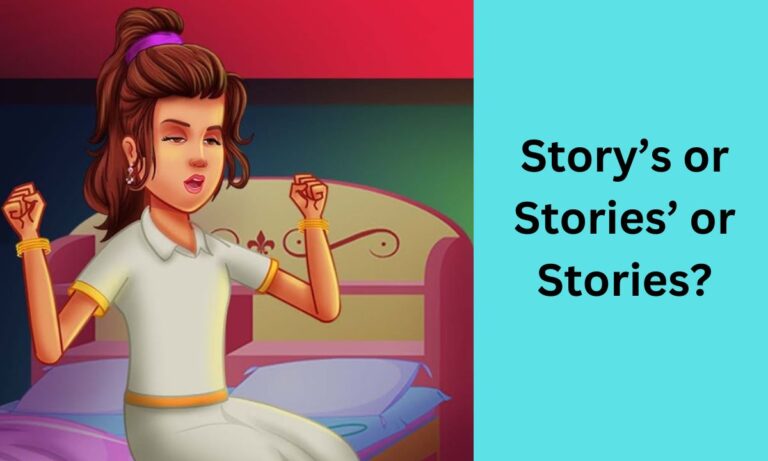Understanding possessive forms and plural forms is essential for mastering English grammar. Words like story’s, stories’, and stories can often cause confusion, especially when discussing possession and pluralization.
This guide will break down each form, explain grammar rules, and provide examples to clarify their correct usage. Whether you’re a student, teacher, or writer, these tips will help you use possessives correctly in writing.
What is the Difference Between Story’s, Stories’, and Stories?
To use these words correctly, you must understand the difference between singular, plural, and possessive forms.
- Story’s – Singular possessive (something belongs to one story)
- Stories’ – Plural possessive (something belongs to multiple stories)
- Stories – Plural form (more than one story, no possession involved)
Comparison Table
| Word | Type | Form | Example |
| Story | Singular | Singular Form | I read an interesting story. |
| Stories | Plural | Plural Form | He has written many stories. |
| Story’s | Singular Possessive | ‘s (Possessive) | The story’s ending was surprising. |
| Stories’ | Plural Possessive | s’ (Possessive) | The stories’ morals were inspiring. |
Now, let’s explore each form in detail.
Singular Possessive: Story’s
The word story’s is the singular possessive form of story. It is used when something belongs to or is related to a single story.
Examples:
- The story’s message was clear and emotional.
- The story’s characters were well-developed.
- The story’s setting transported readers to another world.
Here, the apostrophe + s (‘s) shows that something belongs to the story.
Read This Blog: 25 Synonyms for “It Was Great Catching up With You After a Long Time” (With Examples)
Plural Possessive: Stories’
The word stories’ is the plural possessive form of stories. It is used when something belongs to multiple stories.
Examples:
- The stories’ morals were diverse and thought-provoking.
- The stories’ endings left the readers in suspense.
- The stories’ themes reflected various cultural perspectives.
The apostrophe is placed after the “s” in the plural form to indicate possession by more than one story.
Plural Form: Stories
The word stories is simply the plural form of story. It refers to more than one story without showing possession.
Examples:
- I love reading stories from different cultures.
- The teacher shared some amazing stories in class.
- Fairy stories often have magical elements.
No apostrophe is needed when using the plural form without possession.
Read This Blog: 25 Other Ways to Say “Sorry for Your Loss” (See Examples)
Understanding Possessive Grammar Rules
To use possessive forms correctly, follow these grammar rules:
- Singular nouns take ‘s for possession. (Example: the story’s plot)
- Plural nouns ending in “s” take only an apostrophe after “s”. (Example: the stories’ themes)
- Irregular plural nouns (like “children”) take ‘s. (Example: the children’s books)
Following these simple rules will ensure proper usage of possessive forms.
Example Sentences with Singular and Plural Possessives
| Singular Possessive | Plural Possessive |
| The story’s climax was surprising. | The stories’ endings were unpredictable. |
| The writer’s book was a bestseller. | The writers’ books won awards. |
| The reader’s opinion mattered. | The readers’ feedback was helpful. |
The Plural Suffix “-ies”
Many nouns ending in “y” change to “ies” when pluralized.
Examples:
- Story → Stories
- Category → Categories
- Country → Countries
When forming the plural, no apostrophe is needed unless it shows possession.
Common Mistakes with Possessive Apostrophe Usage
Many writers make errors when using apostrophes. Here are some common mistakes:
- Incorrect: The story’s are exciting. (Incorrect plural)
- Correct: The stories are exciting.
- Incorrect: The story’s theme was deep. (Missing apostrophe for possession)
- Correct: The story’s theme was deep.
- Incorrect: The stories’s morals were strong. (Incorrect possessive placement)
- Correct: The stories’ morals were strong.
To avoid mistakes, always check plural vs. possessive rules before writing.
Story Rephrasing and Possession in Context
You can rephrase possessive sentences to avoid confusion.
- The story’s characters → “The characters of the story.”
- The stories’ morals → “The morals of the stories.”
Using alternative phrasing can make writing clearer and easier to read.
Frequently Asked Questions
When should I use “story’s”?
Use story’s when referring to something that belongs to one story. (Example: The story’s message was inspiring.)
What is the difference between “stories’” and “stories”?
Stories’ shows possession (Example: The stories’ lessons were valuable.)
How do I form the plural of “story”?
To form the plural, change story to stories by replacing “y” with “ies”.
Does “stories” ever need an apostrophe?
Only if showing possession. (Example: The stories’ meanings were deep.)
Is “story’s” correct for multiple stories?
No, “story’s” is only for one story. Use stories’ for multiple stories.
Conclusion
Understanding story’s, stories’, and stories helps in mastering English writing. By applying these grammar rules, you can avoid mistakes and improve clarity in your writing. Whether you’re writing stories’ morals or a story’s theme, using the correct form makes a difference.

David is a talented content writer and digital marketer with expertise in SEO, social media management, and online marketing.

